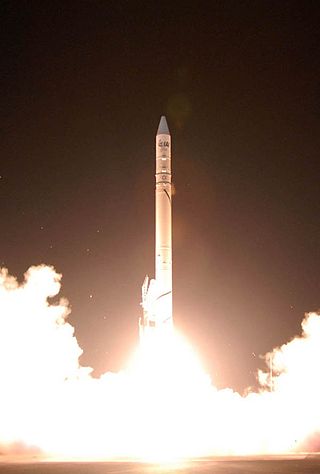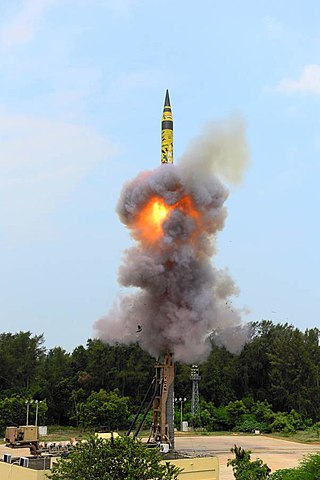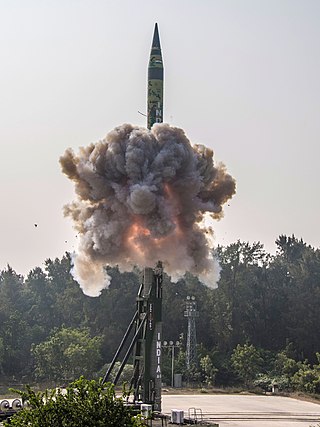
An intercontinental ballistic missile (ICBM) is a ballistic missile with a range greater than 5,500 kilometres (3,400 mi), primarily designed for nuclear weapons delivery. Conventional, chemical, and biological weapons can also be delivered with varying effectiveness, but have never been deployed on ICBMs. Most modern designs support multiple independently targetable reentry vehicle (MIRVs), allowing a single missile to carry several warheads, each of which can strike a different target. The United States, Russia, China, France, India, the United Kingdom, Israel, and North Korea are the only countries known to have operational ICBMs.

A ballistic missile (BM) is a type of missile that uses projectile motion to deliver warheads on a target. These weapons are powered only during relatively brief periods—most of the flight is unpowered. Short-range ballistic missiles (SRBM) typically stay within the Earth's atmosphere, while most larger missiles are exo-atmospheric. The largest ICBMs are capable of full orbital flight. These weapons are in a distinct category from cruise missiles, which are aerodynamically guided in powered flight and thus restricted to the atmosphere.

The Dongfeng series, typically abbreviated as "DF missiles", are a family of short, medium, intermediate-range and intercontinental ballistic missiles operated by the Chinese People's Liberation Army Rocket Force.

An intermediate-range ballistic missile (IRBM) is a ballistic missile with a range of 3,000–5,500 km, between a medium-range ballistic missile (MRBM) and an intercontinental ballistic missile (ICBM). Classifying ballistic missiles by range is done mostly for convenience; in principle there is very little difference between a low-performance ICBM and a high-performance IRBM, because decreasing payload mass can increase range over ICBM threshold. The range definition used here is used within the U.S. Missile Defense Agency. Some other sources include an additional category, the long-range ballistic missile (LRBM), to describe missiles with a range between IRBMs and true ICBMs. The more modern term theatre ballistic missile encompasses MRBMs and SRBMs, including any ballistic missile with a range under 3,500 km (2,175 mi).

The Agni-III is an Indian intermediate-range ballistic missile inducted into service in 2011 as the successor of the Agni-II. It has a range of 3,500 to 5,000 kilometres and can reach targets deep inside neighbouring countries including PAKISTAN & China.

Shavit 2 is a small lift launch vehicle produced by Israel from 1982 onwards, to launch satellites into low Earth orbit. It was first launched on 19 September 1988, making Israel the eighth nation to have an orbital launch capability after the USSR, United States, France, Japan, People's Republic of China, United Kingdom, and India.

The RT-2PM Topol was a mobile intercontinental ballistic missile designed in the Soviet Union and in service with Russia's Strategic Missile Troops. As of 2014, Russia planned to replace all RT-2PM ICBMs with versions of Topol-M. In December 2023, last Topol regiment was taken off combat duty.

The RT-2 was an intercontinental ballistic missile deployed by the Soviet Union, which was in service from December 1968 until 1976. It was assigned the NATO reporting name SS-13 Savage and carried the GRAU index 8K98. Designed by OKB-1, about 60 were built by 1972.
The UR-200 was an intercontinental ballistic missile (ICBM) developed by Vladimir Chelomey's OKB-52 in the Soviet Union. It was known during the Cold War by the NATO reporting name SS-10 Scrag and internally by the GRAU index 8K81. The design was authorized by the Decisions of the Central Committee of the CPSU of March 16 and August 1, 1961, and the draft project was finished in July 1962. It first flew on November 4, 1963, from the Baikonur Cosmodrome. The ninth and final flight was conducted on October 20, 1964.

A nuclear triad is a three-pronged military force structure of land-based intercontinental ballistic missiles (ICBMs), submarine-launched ballistic missiles (SLBMs), and strategic bombers with nuclear bombs and missiles. Countries build nuclear triads to eliminate an enemy's ability to destroy a nation's nuclear forces in a first-strike attack, which preserves their own ability to launch a second strike and therefore increases their nuclear deterrence.

The Agni missile is a family of medium to intercontinental range ballistic missiles developed by India, named after one of the five elements of nature. Agni missiles are long-range, nuclear weapons capable, surface-to-surface ballistic missiles. The first missile of the series, Agni-I was developed under the Integrated Guided Missile Development Programme (lGMDP) and tested in 1989. After its success, the Agni missile programme was separated from the GMDP upon realizing its strategic importance. It was designated as a special programme in India's defence budget and provided adequate funds for subsequent development. As of November 2019, the missiles in the Agni series are being inducted into service. The family comprises the following:

Sejil, or Sejjil, is a family of Iranian solid-fueled medium range ballistic missiles. The Sejil are replacements for the Shahab liquid-fueled ballistic missiles. According to US Pentagon sources, the missile profile of the Sejil closely matches those of the Ashura, Ghadr-110 and the Samen.

Agni-I is a short-range ballistic missile that was developed by DRDO of India in the Integrated Guided Missile Development Program. It is a single-stage missile that was developed after the Kargil War to fill the gap between the 250 km (160-mile) range of the Prithvi-II missile and the 2,500 km (1,600-mile) range of the Agni-II. It was first launched from a road mobile launcher at Integrated Test Range (ITR), Wheeler Island, on 25 January 2002. Less than 75 launchers are deployed.

Agni-V is a land based nuclear MIRV-capable Intercontinental Ballistic Missile (ICBM) developed by the Defence Research and Development Organisation (DRDO) of India. The missile has a range of more than 7,000 km. It is a three-stage, road-mobile, canisterised and solid-fueled ballistic missile.
Agni-VI(Sanskrit: अग्नि; IAST: Agni; lit. Fire) is an MIRV-capable intercontinental ballistic missile under development by the Defence Research and Development Organisation (DRDO) for the Strategic Forces Command (SFC) of the Indian Armed Forces.
India has studied, produced and used various strategic and tactical missile systems since its independence. Decades long projects have realised development of all types of missile systems including ballistic, cruise, anti-ship, air-defence, air-to-air and anti-missile systems. India is one of seven countries in the world with intercontinental ballistic missiles (ICBMs) and one of four countries with anti-ballistic missile systems. Since 2016, India has been a member of Missile Technology Control Regime (MTCR).
This is a comparison list of intercontinental ballistic missiles developed by various countries.
K-6 is an intercontinental submarine-launched ballistic missile under development by Defence Research and Development Organisation of India. The missile has a planned range of around 10,000 to 12,000 kilometres.

Agni-Prime or Agni-P is a two-stage, surface to surface, canister-launched, road mobile and solid-fueled medium-range ballistic missile being developed by India's Defence Research and Development Organisation (DRDO) as the sixth missile in the Agni series. It is intended to be deployed in the operational service of the Strategic Forces Command, and to feature significant upgrades to the composite motor casing, a maneuverable reentry vehicle (MaRV) along with improved propellants, navigation and guidance systems.













